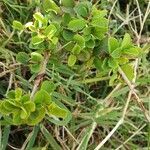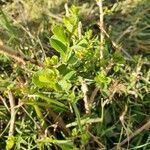Shrubs 1-6 m tall, glabrous; branchlets sharply angular when young, reddish brown, smooth, later darker and lenticellate; ultimate branchlets not spine-tipped. Stipules lanceolate, 1.5-3 mm, entire or margins minutely lacerate; petiole 2-9 mm; leaf blade elliptic, oblong, obovate, or rotund, 2-5 × 1-3 cm, papery, base obtuse to cuneate, margin entire, slightly revolute when dry, apex rounded to acute, mucronulate, white-green abaxially; lateral veins 5-8 pairs. Plants dioecious. Inflorescences axillary, fascicled; bracts scarious, mostly less than 1 mm. Male flowers: pedicels slender, 3-6 mm; sepals 5, ovate, 0.8-1.5 × 0.6-1.2 mm, yellowish, margins entire or obscurely serrulate; disk segments 5, angular, free; stamens 5; filaments 1-3 mm; anthers ellipsoid, 0.4-0.7 mm, exserted from sepals; rudimentary ovary 0.8-1.4 mm high, usually 3-partite, recurved at apex. Female flowers: inflorescence (1-)3-10-flowered; pedicels 1.5-12 mm; sepals 5, as in male; disk annular, entire; ovary ovoid, 3-locular; styles 0.7-1.1 mm, connate at base, bifid at apex, lobes spreading or reflexed. Berry subglobose to oblate, 3-5 mm in diam., whitish when ripe, indehiscent. Seeds chestnut brown, often shiny, faintly reticulate or verruculose; testa thickened; hilum rounded, with a pronounced adaxial invagination. Fl. Mar-Aug, fr. Jun-Nov.
A small shrub. It normally has many stems. The bark is reddish-brown. It grows 2-6 m high and spreads 1-2 m wide. It loses its leaves during the dry season. The branches are angular and sometimes have spines. The leaves are in 2 rows arranged alternately. The leaves are oval and vary in size. The blade is 3.5-8.5 cm long by 2.5-5.5 cm wide. They are light green above and paler underneath. The veins form a network and are prominent underneath the leaf. The tip is pointed. The flowers are tiny and cream with male and female flowers on separate trees. They are 0.1-0.2 cm long and in clusters in the axils of leaves. There are more male flowers than female. The fruit is a round fleshy berry. It is 0.5-0.8 cm across. The fruit are white when ripe and contain 3-4 small seeds. The fruit is edible.








